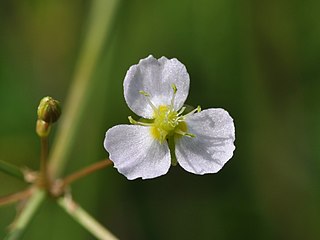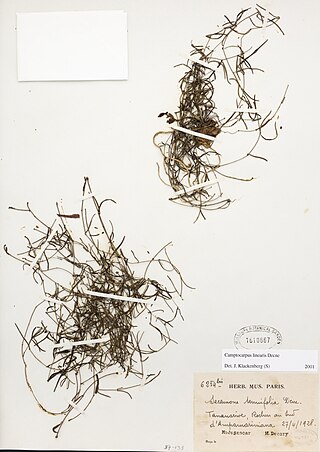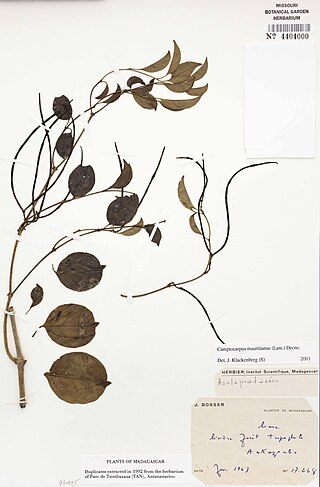
Alisma plantago-aquatica, also known as European water-plantain, common water-plantain or mad-dog weed, is a perennial flowering aquatic plant widespread across most of Europe and Asia, and apparently spread elsewhere in both the Old and New World.

Eriophorum is a genus of flowering plants in the family Cyperaceae, the sedge family. They are found in the cool temperate, alpine, and Arctic regions of the Northern Hemisphere, primarily in the middle latitudes of North America, Europe, and Asia.

Joseph Decaisne was a French botanist and agronomist. He became an aide-naturaliste to Adrien-Henri de Jussieu (1797–1853), who served as the chair of rural botany. It was during this time that he began to study plants brought back by various travelers like those of Victor Jacquemont (1801–1832) from Asia. Decaisne used applied research, most notably on the agronomy of the madder, the yam and the ramie. He was also interested in algae.

Trillium rugelii is a species of flowering plant in the family Melanthiaceae. It is endemic to the southeastern United States. Its white flower is typically found nodding beneath the leaves, hence it is known as the southern nodding trillium. The specific epithet rugelii honors Ferdinand Rugel, a botanist and plant collector who collected plant specimens throughout the southeastern U.S. during the period 1840–1848. Although the species is apparently secure across its range, statewide it is vulnerable at best.

Trillium cernuum is a species of flowering plant in the bunchflower family Melanthiaceae. The specific epithet cernuum means "drooping, curving forwards, facing downwards", a distinctive habit of its flower. It is commonly called nodding trillium or nodding wakerobin since the flower is invariably found nodding beneath the leaves. It is sometimes referred to as the northern nodding trillium to distinguish from Trillium rugelii, a similar nodding species native to the southern Appalachian Mountains. It is also called the whip-poor-will flower since presumably its bloom coincides with the spring arrival of the migrating bird with the same name.

Plantago maritima, the sea plantain, seaside plantain or goose tongue, is a species of flowering plant in the plantain family Plantaginaceae. It has a subcosmopolitan distribution in temperate and Arctic regions, native to most of Europe, northwest Africa, northern and central Asia, northern North America, and southern South America.

Rugelia nudicaulis, the sole species of the genus Rugelia, blooms in summer. It is a wildflower endemic to higher elevations in the Great Smoky Mountains. It is a rare species in Tennessee. Genetic diversity in this plant, assessed using allozymes, is so low that the species may not survive changing environmental conditions. Both the scientific name and the common names honor Ferdinand Rugel, a botanist and plant collector who collected plant specimens throughout the southeastern United States during the period 1840–1848.

Trillium petiolatum, the Idaho trillium, also known as the long-petioled trillium or round-leaved trillium, is a species of flowering plant in the family Melanthiaceae. It is native to the northwestern United States, in Idaho, Oregon, and Washington. Its type specimen was gathered by Meriwether Lewis during the return trip of the Lewis and Clark Expedition in 1806.

Arisaema quinatum is a species of flowering plant in the arum family Araceae. It is a member of the Arisaema triphyllum complex, a group of closely related taxa in eastern North America. The specific name quinatum means "divided into five lobes", a reference to its characteristic leaves. It is commonly known as the southern Jack-in-the-pulpit but some refer to it as Preacher John.

Desmodium glabellum is a species of flowering plant in the legume family Fabaceae. It is native to the eastern and central United States. It is commonly called Dillenius' tick-trefoil in honor of Johann Dillenius, a British botanist of German birth. It is also known as the tall tick-trefoil.

Lithospermum tuberosum, commonly called the southern stoneseed or tuberous stoneseed, is a species of flowering plant in the forget-me-not family. It is native to the Southeastern United States, where it is found in calcareous woodlands.

Plantago brownii is a species of flowering plant in the family Plantaginaceae that is native to Tasmania, Australia and the subantarctic Auckland Islands of New Zealand. Robert Brown described the species in 1810, as P. carnosa R.Br. Plants of this species of plantain are annual or perennial with a rosette habit, fleshy toothed leaves, and short inflorescences.

Plantago indica, commonly known as branched plantain, sand plantain, or black psyllium, is a flowering plant in the plantain family Plantaginaceae, and is one of a few species in the Plantago genus under the common name psyllium. The plant is native to parts of Africa, Europe, Russia, and Asia, and has been naturalized in many other areas such as Australia and North America. The plant can be found mostly in dry inland areas, such as those that are sandy, and has also naturalized on roadsides and in meadows. The plant is not used broadly as a food source, but has been cultivated for its seeds which serve a medicinal use as a laxative.

Camptocarpus crassifolius is a species of plant in the Apocynaceae family. It is endemic to Madagascar. Joseph Decaisne, the botanist who first formally described the species, named it after its thick leaves.

Camptocarpus linearis is a species of plant in the Apocynaceae family. It is endemic to Madagascar. Joseph Decaisne, the botanist who first formally described the species, named it after its narrow leaves.

Camptocarpus mauritianus is a species of plant in the Apocynaceae family. It is native to Comoros, Madagascar and Réunion. Jean-Baptiste Lamarck, the naturalist who first formally described the species named it, using the synonym Cynanchum mauritianum, after the region of the Indian Ocean that includes the island of Mauritius, although the type specimen he examined did not list a specific location.
Plantago helleri, the cedar plantain or Heller's plantain, is a species of flowering plant in the family Plantaginaceae, native to New Mexico, Texas, and northeastern Mexico. It is an annual reaching 30 cm (1 ft).

Plantago raoulii is a species of flowering plant in the family Plantaginaceae that is endemic to New Zealand. Joseph Decaisne described P. raoulii in 1852. Plants of this species of plantain are perennial with a rosette habit, leaves widest above the middle, usually 5 seeds in a specific arrangement in each capsule, and bracts with mostly glabrous edges. It is listed as Not Threatened.

Eriophorum virginicum, the tawny cottongrass, is a species of flowering plant in the sedge family Cyperaceae. It is native to eastern North America but was introduced into both British Columbia and Washington in western North America. It is most common in eastern Canada, New England, and the Great Lakes region. It is the only species of Eriophorum in North America that occurs in the southeastern United States, where it is uncommon. The common name refers to the tawny color of its fruiting head. Despite the name, it is a sedge, not a grass, and it is sometimes called tawny cottonsedge to emphasize this fact.
Ferdinand Ignatius Xavier Rugel was a German-born American pharmacist, botanist, and plant collector.






















